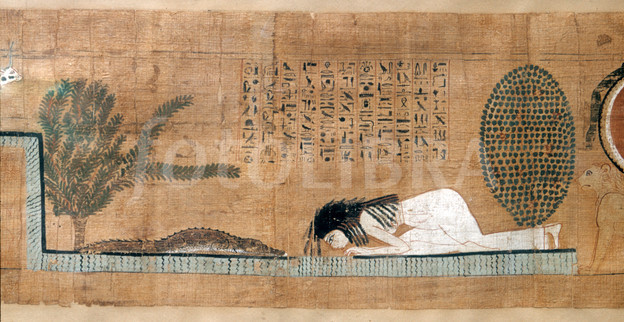
Papyrus and the Crocodiles

Throughout Egyptian history, the tradition persists that any boat made of papyrus would repel crocodiles. I had only one opportunity to test this out. It happened on Lake Tana in Ethiopia, one of the many lakes in Africa where papyrus grows in abundance. It was from this lake that in 1969 Thor Heyerdahl shipped tons of papyrus to build his ships, Ra I and Ra II. The lake is also famous as the source of the Blue Nile. I was there to collect samples of papyrus for analysis. I intended to take them back to Kampala, where I was comparing papyrus plants collected from other places to see if there were any regional differences.I landed at a small airstrip near the lake and checked into the government hotel, where I explained my intentions to the manager. He told me he would help me locate the owner of a tanqwa, a canoe made of papyrus. The next morning a fisherman was waiting to show me a proper tanqwa made of papyrus stems sewn together and fitted with a bundle of stems as ballast in the center, a method not changed for thousands of years. He offered to help me collect the samples of papyrus that I needed and, once we agreed on a price, we set off from the hotel landing. He poled us out along a channel close to shore, a channel that ran some distance before we reached the open lake, a body of water 1,350 sq. miles in area.
That day the surface was calm and we made good progress, but not far from the hotel I spotted a large specimen of Crocodylus niloticus. I say "large" because this beast was at least 16ft long. When the Greeks first saw one in Egypt they called it a krokodilos, after their old word for a lizard, or "stone worm." To them, this "stone worm" was so called because of its habit of basking in the sun on rocky areas near riverbanks. True to their ancient observation, this specimen was basking on a stony outcrop close to shore, so close that we would have to pass under its snout if we held our course. We were still in the channel and hemmed in by papyrus on one side and the shore on the other side, on which lay this man-killer with jaws now wide open, glaring at us.
I turned to the fisherman and indicated excitedly that he should backpaddle --- and fast. He had the only paddle and I could do nothing, as I was balanced precariously on top of the bundle of papyrus stems used for ballast. The least movement seemed to tip the boat, but he only smiled and said in accented English, "No worry, crocodile is afraid."
Was I having a bad dream, I wondered? Here we were, aimed straight at an animal that was about 2 or 3ft longer than our canoe and at least three times as heavy, and to make matters worse, if we continued in this direction the prow would poke him right in the nose.
Perhaps reading my mind, the crocodile made a loud noise halfway between a bellow and a hiss. Frantically I again turned and motioned to the fisherman, who smiled as usual and said, "See," and with several strokes propelled us straight at the animal.
The next few minutes seemed an eternity. I was reconciled to a savage, watery death --- but suddenly the crocodile got up on its four legs and, as the animal behaviorists say, "high walked" off the stony ledge into the muddy water. Once there, with several powerful lashes of its tail it quickly swam away from us. As it disappeared down the channel I turned and looked at the fisherman, who smiled a third time and shrugged his shoulders. "They are much afraid of papyrus boat!" he said. And I thought, though Isis may have established this with her canoes, I don't think I'll ever have the guts to try it again.
--- From Papyrus ---
The Plant That Changed the World
John Gaudet
©2014 Pegasus Books